Fungal parasitic insects harm both the mushrooms themselves and the substrate. Or rather, the insects themselves are quite harmless.
Since both mycelium and mushrooms are eaten by their larvae.
Often the mosquitoes or midges themselves are not noticeable in the growing room, however, if they laid eggs in bags with substrate, larvae hatch in them. The larvae feed on the mycelium.
If there are many of them, the block becomes completely dark. That is, the larvae do not gnaw the raw material of the substrate, but they eat the mycelial hyphae, which we see as a white mass.
There are types of larvae that reproduce in a bag of substrate over and over again, without developing into flying individuals.
See photos in this article and in my video.
There are many types of larvae here. They range in length from 2 millimeters to several centimeters. The color of the larvae can be various shades of white, orange and brick red. As a rule, the pupae of various flies have a brownish-brick hue.
They can be with or without legs, the head is either black or the same as the rest of the body, you won’t even be able to understand where its head is.
Most often, mushrooms wither due to the larvae gnawing on the lower part of the bunch.
Because of this, the primordia become soft, as if cotton wool, and change color to brown or reddish-orange.
If the entire oyster mushroom druse suddenly begins to wither, be sure to take a magnifying glass, pick this bunch and examine it.
At the base of such a bunch (some mushroom growers call it the “butt of the bunch”) you can see small passages-holes, gnawed out by the larvae.
And sometimes you can even see them themselves - near the perforation in which the druse has grown or near the mushroom stems, see the photo at the top right.
Or in the substrate under the film, see pictures below.
It is easier to find the larvae with a magnifying glass by tearing out a damaged bunch with a piece of substrate.
Crush the substrate with your fingers onto a white sheet and look through a magnifying glass.
You can also put the crushed piece in a jar of water and shake it, look at the light. Larvae will be visible in the water.
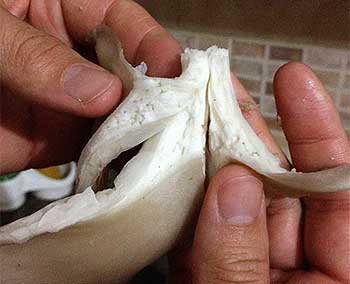
The passages that larvae have gnawed on large mushrooms can be seen even without a magnifying glass.
The larvae look like small worms that are white, orange or red.
They gnaw passages in the fruiting bodies themselves.
When you tear the cap along the gill, you can see that all the flesh is perforated.
To monitor the presence of insects in the workplace, it is necessary to have traps or adhesive tape in all areas.
Note! Traps are only used to track and not kill insects! Sticky tape won't kill all the midges, don't even hope for it.
How to get rid of mushroom flies
Great places to lay eggs are:
Here's what happens:
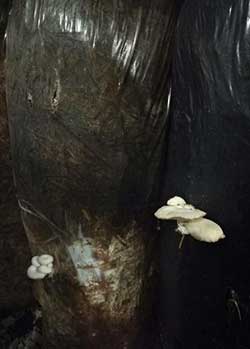
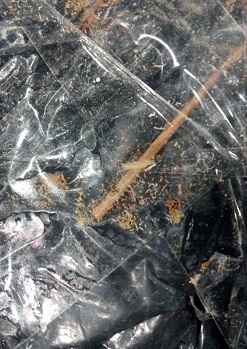
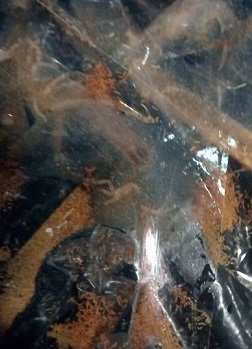
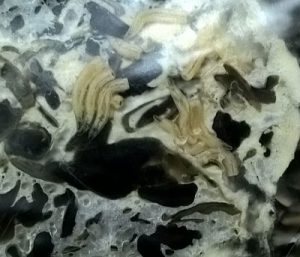
In search queries they write “worms on oyster mushrooms”, “worms in a block with oyster mushrooms” or “maggots are infested”.
I didn’t dare call the larvae “worms” so that a search engine would find my article, but some individuals really look like them.
It is extremely rare that nematodes, real roundworms, very small 1-2 ml in length, can appear.
For prevention, empty incubators and grow chambers should be treated with insecticides.
If a batch is infected and detected in the early stages of incubation, it is permissible to treat the incubator with insecticides using an aerosol or smoke bombs.
But this makes sense if there are larvae only in perforations in two or three blocks. If they are visible en masse to the naked eye under the film, then it is necessary to immediately empty the entire incubator and take the packages away from the enterprise. Turn out the contents of the bag and bury it. It is advisable to burn the film. If this is not possible, send the film to an organized waste collection site. Which is popularly called a city dump.
Read: how to carry out sanitary treatments.
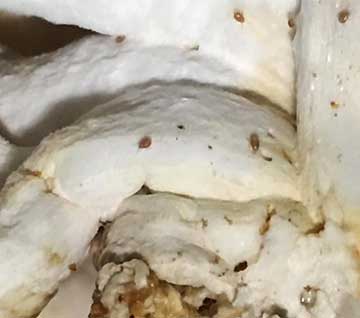
This is a red spider mite. They are not insects, actually, but they are very similar.
These mites belong to the class of arachnids.
In order to get rid of them, it is best to take insectoacaricides that are recommended for home flowers or greenhouses.
Since many acaracids are too poisonous, they are not recommended for use indoors. Therefore, read the instructions carefully - it must say that the drug can be used in buildings.
Ticks do not like cool climates with high humidity.
If you cannot keep the growing chamber cool in the summer, it is better to stop block production.
And treat all rooms with chemicals - against mold, and after a few days - against ticks and insects.
